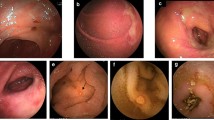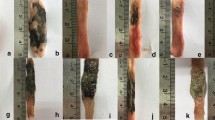Abstract
Indomethacin administration in animals increases permeability of the small intestine, leading to inflammation that mimics Crohn’s disease. Nonsteroidal anti-inflammatory drugs increase the permeability of the intestinal epithelial barrier and should therefore be used with caution in patients with Crohn’s disease. We analyzed the protective effects of octreotide and the tumor necrosis factor-alpha inhibitor infliximab in a rat model of indomethacin-induced enterocolitis. Male Wistar rats received 20 mg of infliximab or 10 μg of octreotide 24 h prior to injection with indomethacin. Intestinal permeability was analyzed using Cr-51-ethylenediaminetetraacetic acid clearance. No microscopic or macroscopic alterations were observed in the rats receiving infliximab or octreotide, both of which increased permeability (P < 0.001 versus controls). Our macroscopic and microscopic findings might be related to the low specificity of infliximab and suggest that cytokines affect the intestinal epithelial barrier, as evidenced by the protective effect that infliximab had on the permeability parameters evaluated.
Similar content being viewed by others
References
Elson CO, Sartor RB, Tennyson GS, Riddell RH (1995) Experimental models of inflammatory bowel disease. Gastroenterology 109(4):1344–1367
Strober W (1985) Animal models of inflammatory bowel disease—an overview. Dig Dis Sci 30(12 Suppl):3S–10S
Kent TH, Cardelli RM, Stamler FW (1969) Small intestinal ulcers and intestinal flora in rats given indomethacin. Am J Pathol 54(2):237–249
Peeters M, Geypens B, Claus D, Nevens H, Ghoos Y, Verbeke G et al (1997) Clustering of increased small intestinal permeability in families with Crohn’s disease. Gastroenterology 113(3):802–807
Ford J, Martin SW, Houston JB (1995) Assessment of intestinal permeability changes induced by nonsteroidal anti-inflammatory drugs in the rat. J Pharmacol Toxicol Methods 34(1):9–16
Mahmud T, Somasundaram S, Sigthorsson G, Simpson RJ, Rafi S, Foster R et al (1998) Enantiomers of flurbiprofen can distinguish key pathophysiological steps of NSAID enteropathy in the rat. Gut 43(6):775–782
Bjarnason I, Zanelli G, Prouse P, Smethurst P, Smith T, Levi S et al (1987) Blood and protein loss via small-intestinal inflammation induced by non-steroidal anti-inflammatory drugs. Lancet 2(8561):711–714
Sartor RB (1994) Cytokines in intestinal inflammation: pathophysiological and clinical considerations. Gastroenterology 106(2):533–539
Bertrand V, Guimbaud R, Tulliez M, Mauprivez C, Sogni P, Couturier D et al (1998) Increase in tumor necrosis factor-alpha production linked to the toxicity of indomethacin for the rat small intestine. Br J Pharmacol 124(7):1385–1394
Suenaert P, Bulteel V, Lemmens L, Noman M, Geypens B, Van Assche G et al (2002) Anti-tumor necrosis factor treatment restores the gut barrier in Crohn’s disease. Am J Gastroenterol 97(8):2000–2004
van Bergeijk JD, Wilson JH, Nielsen OH, von Tirpitz C, Karvonen AL, Lygren I et al (2002) Octreotide in patients with active ulcerative colitis treated with high dose corticosteroids (OPUS 1). Eur J Gastroenterol Hepatol 14(3):243–248
Eliakim R, Karmeli F, Okon E, Rachmilewitz D (1993) Octreotide effectively decreases mucosal damage in experimental colitis. Gut 34(2):264–269
Kucharzik T, Lugering A, Lugering N, Rautenberg K, Linnepe M, Cichon C et al (2000) Characterization of M cell development during indomethacin-induced ileitis in rats. Aliment Pharmacol Ther 14(2):247–256
Bernardes-Silva CF, Damiao AO, Sipahi AM, Laurindo FR, Iriya K, Lopasso FP et al (2004) Ursodeoxycholic acid ameliorates experimental ileitis counteracting intestinal barrier dysfunction and oxidative stress. Dig Dis Sci 49(10):1569–1574
Goncalves J, Queiroz G (1996) Purinoceptor modulation of noradrenaline release in rat tail artery: tonic modulation mediated by inhibitory P2Y- and facilitatory A2A-purinoceptors. Br J Pharmacol 117(1):156–160
Wyatt J, Vogelsang H, Hubl W, Waldhoer T, Lochs H (1993) Intestinal permeability and the prediction of relapse in Crohn’s disease. Lancet 341(8858):1437–1439
Garcia-Lafuente A, Antolin M, Guarner F, Crespo E, Malagelada JR (2001) Modulation of colonic barrier function by the composition of the commensal flora in the rat. Gut 48(4):503–507
Hogenauer C, Aichbichler B, Santa Ana C, Porter J, Fordtran J (2002) Effect of octreotide on fluid absorption and secretion by the normal human jejunum and ileum in vivo. Aliment Pharmacol Ther 16(4):769–777
Lamrani A, Tulliez M, Chauvelot-Moachon L, Chaussade S, Mauprivez C, Hagnere AM et al (1999) Effects of octreotide treatment on early TNF-alpha production and localization in experimental chronic colitis. Aliment Pharmacol Ther 13(5):583–594
Suenaert P, Bulteel V, Vermeire S, Noman M, Van Assche G, Rutgeerts P (2005) Hyperresponsiveness of the mucosal barrier in Crohn’s disease is not tumor necrosis factor-dependent. Inflamm Bowel Dis 11(7):667–673
Colpaert S, Liu Z, De Greef B, Rutgeerts P, Ceuppens JL, Geboes K (2001) Effects of anti-tumour necrosis factor, interleukin-10 and antibiotic therapy in the indometacin-induced bowel inflammation rat model. Aliment Pharmacol Ther 15(11):1827–1836
Author information
Authors and Affiliations
Corresponding author
Rights and permissions
About this article
Cite this article
Cury, D.H.B., Costa, J.E., Irika, K. et al. Protective Effect of Octreotide and Infliximab in an Experimental Model of Indomethacin-Induced Inflammatory Bowel Disease. Dig Dis Sci 53, 2516–2520 (2008). https://doi.org/10.1007/s10620-007-0172-z
Received:
Accepted:
Published:
Issue Date:
DOI: https://doi.org/10.1007/s10620-007-0172-z




